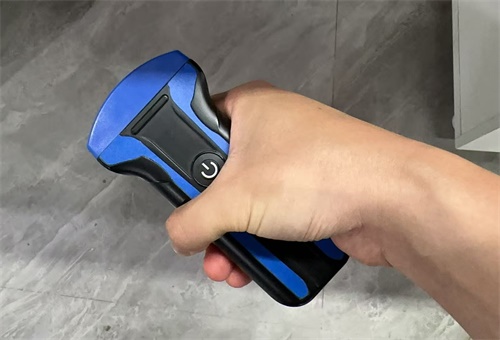When people talk about veterinary technology, the image of a handheld scanner often comes up. Farmers, breeders, and pet owners are curious: can a handheld vet scanner really make a difference in animal healthcare? The short answer is yes. But to understand why, we need to dive deeper into what these devices do, how they compare to traditional equipment, and what benefits and limits they bring.

What Is a Handheld Vet Scanner?
A handheld vet scanner is a portable ultrasound device designed specifically for animals. Unlike large cart-based ultrasound machines in hospitals, these scanners are compact, lightweight, and battery-powered. A veterinarian or farmer can hold it in one hand while using the other to guide the probe across the animal’s body.
The core idea is convenience. Ultrasound has long been used in veterinary care, but bulky machines limit mobility. A handheld scanner allows real-time imaging anywhere—in barns, fields, or clinics—without needing to bring animals into a hospital. This makes it especially valuable in livestock farming, where moving cattle or sheep to a medical facility can be stressful and costly.
How Does It Work in Practice?
The scanner works just like a human ultrasound machine. A probe sends sound waves into the body, and the echoes form an image of organs, tissues, or pregnancies. The images can be viewed directly on the device screen or wirelessly transmitted to a smartphone or tablet.
For example, a farmer may want to check if a ewe is pregnant. Instead of waiting for a vet with large equipment, a handheld scanner can be used directly in the pen. Within minutes, the farmer knows whether the ewe is carrying lambs and can make feeding and breeding decisions right away. This direct access to information helps save time and reduces unnecessary costs.
Why Portability Matters in Veterinary Care
Animals are not always easy to transport. A sick horse, for example, may not be safe to move. A cow in late pregnancy should not travel long distances to a clinic. This is where handheld vet scanners shine. They bring the diagnostic tool to the animal rather than the other way around.
This shift reduces stress on animals, which is important because stress can negatively affect both health and reproduction. Farmers also benefit, as they avoid hiring transport services or losing time during critical breeding seasons. In simple terms, portability equals practicality.
Differences Between Handheld and Traditional Ultrasound
At first, you might wonder if a handheld scanner can match the power of a traditional ultrasound system. The truth is that handheld devices are improving quickly, but they still have some differences compared to larger machines.
Here’s a quick comparison:
| Feature | Handheld Vet Scanner | Traditional Ultrasound Machine |
|---|---|---|
| Portability | Lightweight, battery-powered, easy to carry | Large, heavy, fixed in clinic |
| Image Quality | Good, improving each year | Higher resolution, more advanced modes |
| Cost | Affordable for farmers and small clinics | Expensive, often only in hospitals |
| Ease of Use | Simple controls, quick learning curve | Requires training, more complex |
| Best For | Pregnancy checks, field diagnosis | Detailed exams, complex cases |
This table shows the trade-off: handheld scanners prioritize portability and accessibility, while traditional machines focus on maximum precision and versatility.
Applications in Large Animals
In livestock farming, handheld scanners are a game-changer. Cattle, sheep, and pigs all benefit from portable ultrasound checks. Pregnancy detection is the most common use, but it’s not the only one. Vets can also check for uterine infections, monitor fetal development, and assess reproductive organs.
For farmers, early detection means better planning. Knowing which cows are pregnant allows efficient feed allocation and breeding schedules. In sheep, scanning helps identify ewes carrying twins or triplets, so nutrition can be adjusted to avoid lamb losses. These small adjustments can significantly improve farm productivity and profitability.
Applications in Small Animals
Handheld scanners are not just for farms. Pet clinics and shelters also use them. Dogs and cats can be scanned quickly without needing sedation in most cases. A handheld scanner helps vets check for bladder stones, abdominal tumors, or pregnancy in small animals.
For pet owners, this means faster answers without expensive hospital visits. A small clinic equipped with a handheld scanner can provide affordable care while still giving accurate information. This democratizes access to veterinary diagnostics, which is especially important in rural or low-income areas.
The Learning Curve for Farmers and Vets
One of the most attractive features of handheld vet scanners is their simplicity. Many are designed with straightforward menus and touchscreens. Some even connect to mobile apps that guide the user step by step.
However, while the device is easy to operate, interpreting ultrasound images still requires training. A blurry image can be misread, leading to wrong conclusions. This is why handheld scanners are most effective when used by trained veterinarians or farmers who have received proper instruction. Companies that sell these devices often provide short training courses to ensure users can read images correctly.
Cost and Accessibility
Price plays a big role in adoption. Traditional ultrasound systems can cost tens of thousands of dollars. Handheld scanners, on the other hand, are often priced at a fraction of that, making them accessible to individual farmers, breeders, and small animal clinics.
This affordability has helped spread ultrasound technology beyond specialized clinics into everyday use. It allows farms to run checks more frequently, catching problems earlier and preventing larger losses. When technology becomes affordable, it stops being a luxury and starts being a tool for everyone.
Limitations of Handheld Vet Scanners
Of course, handheld vet scanners are not perfect. Their smaller size often means fewer advanced imaging modes, such as Doppler for blood flow measurement. The resolution may not match that of high-end machines. Battery life can also be a challenge in continuous use.
Another limitation is durability. While many handheld scanners are designed for field use, rough handling or extreme weather can affect performance. Farmers need to balance portability with care to ensure the device lasts.
Still, for most routine checks—especially pregnancy detection—these limitations are minor compared to the convenience and cost savings.
The Future of Veterinary ultrasound
Handheld vet scanners are evolving fast. Each new generation brings sharper imaging, better connectivity, and smarter software. Some now feature cloud storage, allowing vets to share images instantly with specialists. Others integrate artificial intelligence that assists with interpreting results.
As these improvements continue, the line between handheld and traditional ultrasound will blur. It is likely that in the near future, portable scanners will cover almost all everyday veterinary needs, with large machines reserved only for the most complex cases.
Conclusion
So, can a handheld vet scanner improve animal healthcare? Absolutely. By combining portability, affordability, and accessibility, it brings diagnostic power directly to farms, clinics, and even remote areas. While it may not yet replace traditional hospital-grade ultrasound machines in every situation, its benefits for both large and small animals are undeniable.
For farmers, it means better breeding management and healthier livestock. For pet owners, it means quicker answers and lower costs. And for veterinarians, it provides a tool that expands their reach and improves their efficiency. The handheld vet scanner is more than a gadget—it is a step toward more practical, humane, and effective animal healthcare.
link: https://www.bxlimage.com/nw/1293.html
tags: portable veterinary ultrasound handheld vet scanner livestock pregnancy check animal healthcare technology vet imaging device ultrasound for pets farm ultrasound scanner






